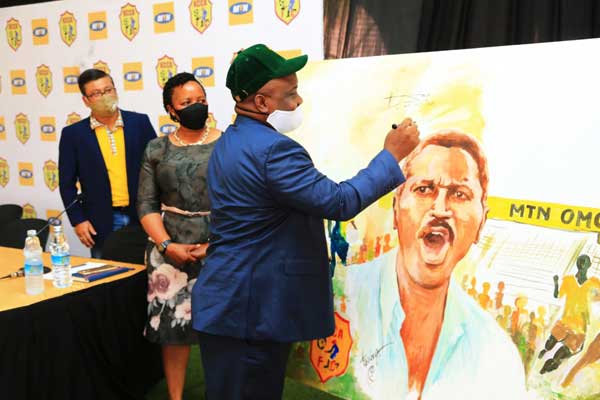Retiring numbers: KCCA champion phenomena by resting Omondi’s #15

Legendary. Lord Mayor Erias Lukwago signs on a mural of Omondi during rebranding of the stadium last year. Below, Maradona and Foe. Photo | Courtesy
What you need to know:
- A sports tradition. It is still alien in the local sports milieu but KCCA’s move could see clubs wake up to honouring their heroes and keeping memories
KCCA have confirmed they will retire jersey number 15 for the upcoming season in honour of their legend Phillip Omondi.
Omondi, who died in 1999, played for KCC (now KCCA) from 1973 to 1979 before moving to the United Arab Emirates to join Sharjah and returning for a second spell between 1983 and 1988. He scored 121 for the Lugogo side in 346 appearances and managed them for a few seasons leading to 1992.
“We want to clarify that we are not retiring the number entirely but just for this season (2021/22) as we construct the stadium,” club chief executive officer (CEO) Anisha Muhoozi, told SCORE.
KCCA are reconstructing one side of the stadium, which they last year named after Omondi, to increase sitting capacity to 10,000 and find the retirement of the jersey a good gesture to couple with the project.
“In future, we suspect that players would want to be associated with the jersey so retiring it completely would be denying them the opportunity.”
The move is one that will be welcome in Lugogo.
Former coach and player Mike Mutebi describes it as “a good gesture that other clubs should follow.”
And being the eccentric character that he is, Mutebi has an extra idea for the seats; “they too should be named after players like Sam Ssimbwa, Jackson Mayanja and other greats.”
Veteran journalist Hassan Badru Zziwa feels KCCA’s idea is “significant because it has never been done locally.”
“If they want to start it, it’s good because we are moving towards the culture of European clubs,” adds Zziwa, who believes the first number to be retired should have been Moses Nsereko’s 14 as he won more trophies as a one club man (between 1975 and 1984) while Omondi has shared 15 with other club greats like Frank Kyazze and George Sserunjogi among others.
Adopted phenomena
The debate will rage on but this practice, long established in the major North American sports, is fast catching up in football for various reasons.
Those who follow basketball will know that players like Wilt Chamberlain, Kareem Abdul-Jabbar have their numbers 13 and 33 retired by all the clubs they played for. Ditto Michael Jordan’s 23 with Chicago Bulls while Kobe Bryant had 8 and 24 retired by the Lakers.
Football is believed to have adopted the gesture in 1977 when Brazilian idol Pele ended his two year stint at New York Cosmos leading the club to retire his number 10 shirt.
In some cases, such as those of Marc-Vivien Foé, Jose Antonio Reyes, Antonio Puerta and Davide Astori, numbers have been retired to posthumously honour a player who died while still active.
In fact, Foe had his 17 retired by Lens and Lyon while the 23 he wore while on loan at Manchester City (club he was playing for at the time of his death) was also momentarily retired.
Lyon returned 17 to the squad list in 2008 – five years after Foe’s demise.
Of numbers that were returned, Barcelona gave shirt 21 to Lillian Thuram in 2006, two years after retiring it in honour of Luis Enrique, who joined them from rivals Real Madrid on a free transfer in 1996 and left in 2004 as captain.
Norwegian club Fredrikstad retired Dagfinn Enerly’s number 8 following an on-pitch accident that left him paralysed.
In Britain, Sir Bobby Moore’s, Jack Lester’s and Jude Bellingham’s shirt numbers were retired due to great service to the club as opposed to a tragic incident.
Bellingham’s shirt 22 at Birmingham City will ring bells as it’s the most recently retired – for his achievement as the club’s youngest player and goal scorer in history before he moved to Bundesliga side Borussia Dortmund.
Huge in Italy
In Italy, there is a huge appetite for honouring legends this way. Napoli started it with keeping away Diego Maradona’s 10 after the success he brought to the city during his 1984-1991 spell.
Another Argentinian Javier Zanetti has also been on the receiving end of the gesture with Inter Milan, the side he represented from 1995-2014, putting away his shirt 4.
Ten years earlier, Brescia had retired Roberto Baggio’s number 10.
But back to the San Siro, shirt 6 has been retired in honour of Franco Baresi’s 20-year spell stretching from 1977 to 1997 at AC Milan.
Interestingly, the same has been done for Paolo Maldini’s shirt 3 but the current AC Milan technical director has allowed his sons to wear it if they want.
Although it has not been officially retired, Gianfranco Zola’s number 25 and John Terry’s 26 have not been reissued by Chelsea since they left the club in 2003 and 2017, respectively.
The issue
Unromantic Fifa
Argentina, Ecuador and Cameroon national teams have been prevented from retiring the numbers of Diego Maradona (10), Christian Benítez (11) and Foé (17), respectively, as Fifa rules for their tournaments require summoned players to be numbered 1 to 23.
Also Leeds retired the number 17 shirt due to Italian chairman Massimo Cellino’s superstitions that consider 17 an unlucky number. The number was reissued in 2019 two years after Cellino had sold the club.
Some clubs in Italy, Brazil, South Korea, Greece, France, China, Australia and Germany among others dedicate shirt numbers, usually 12, to fans and therefore cannot be worn by players.
Dynamo Kiev home and away plus a home win against Benfica.




